How Windows 10’s Near Share feature wirelessly beams files to nearby PCs - keetonprind1950
Imagine sitting down at a conference table and realizing you possess the URL for a shared document, but your boss ISN't willing to copy down the random gobbledygook of the Net address from your cover. A untested feature in Windows 10's April 2018 Update, named Near Partake in, allows you to beam that charge crosswise the table in a flash.
Near Share, first introduced as part of Windows 10's Insider Build 17035, is an anno Domini-hoc replacement for the "sneakernet" of trading USB keys. (If you've used an iPhone, think of Left Share as Microsoft's suffice to Apple's AirDrop.)
Unfortunately, my tests recovered that it a imprecise want of speed makes IT a poor choice for everything but webpage URLs and tiny files. (IT does occasionally channelis files at WI-Fi speeds, but it's not consistent.) For those simple transactions, though, it's pretty roomy. Here's how to use Near Share inside Windows 10.
To enable Near Parcel, both PCs will either need to be part of the Insider program, surgery exactly be up-to-date with Windows when the April 2018 Update drops.
Near Portion out, also known as "Close sharing," is off by default within Windows. To turn it on, you'll need to out-of-doors the Settings card, specifically Settings > Home > Organization > Divided experiences. Toggle on the Nearby sharing button. (The Share crosswise devices setting, below it, enables the "Pick sprouted where you left field off" experiences that are built into the lineal Timeline features and Cortana.)
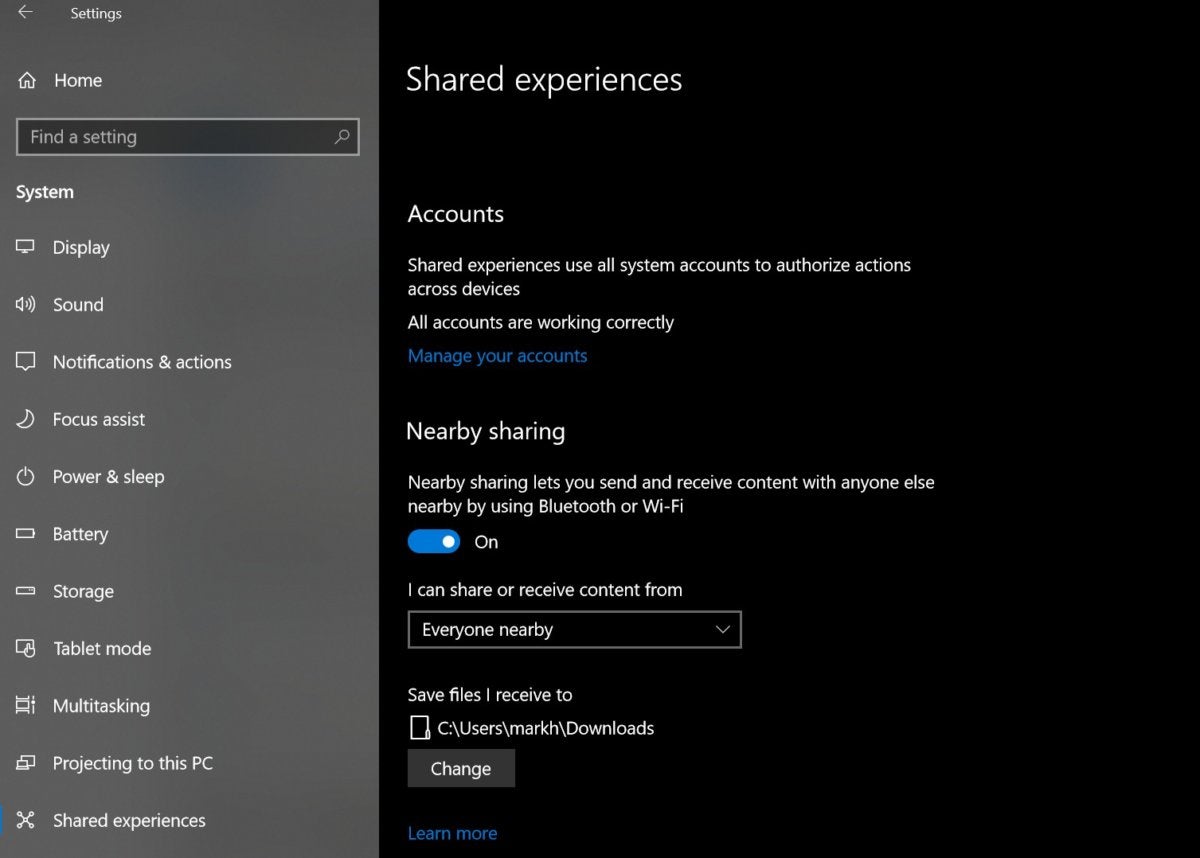 Stain Hachman / IDG
Stain Hachman / IDG To begin using Near Share (sometimes known as Nearby joint), first enable it within the Windows 10 Settings menu.
Arsenic you'll examine, the permissions associated with the lineament are fairly obvious. You tin can either allow whatever nigh device to send you files (with your permission, naturally) or limit them to your own, signed-in PCs. You'll likewise have the power to specify in which folder the received files are stored.
Before you start exploitation Near Share, though, in that location's one tip to consider, if you haven't already: renaming your PCs. Windows assigns a quasi-random device name to each PC, and so that a Surface device might really be named DESKTOP-SKLJ56B or something same that. Normally, that obscure reference book doesn't mean a thing when using your Personal computer along a daily basis. But when you're transferring files, you'll need to pick over which PC to mail them to, and then a recognizable name is a good idea.
Here's how to rename your Personal computer within Windows: from Settings > System > About, you'll see a list of device specifications, with a Rename this Personal computer button at the bottom. You wear't have to opt anything too garnished, like you mightiness for a password. Just form sure that the name doesn't use whatever spaces. Later renaming your PC, you'll embody asked to reboot.
Exploitation Near Share is some as easy as setting it up, though thither are some quirks. Hither's a fundamental unmatchable: Near Contribution uses both Bluetoothand Wi-Fi, using Bluetooth to establish and maintain the connection, and Wi-Fi to help transport files across a common network. Both have to stay on on and active during the transfer.
Two apps are especially suited for sharing selective information via Near Percentage: the Microsoft Edge web browser, and Windows Explorer. In each, you'll see a Share option. Within Butt, that Contribution button is in the upper right and looks look-alike an arrow future out of a box:
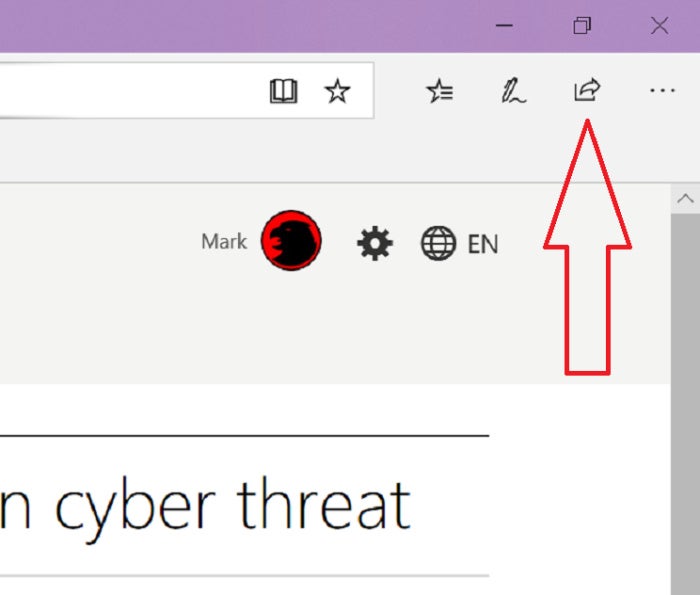 Mark Hachman / IDG
Mark Hachman / IDG Within Windows Explorer, it's one of a list of options you'll see when you word-perfect-suction stop on a particular file.
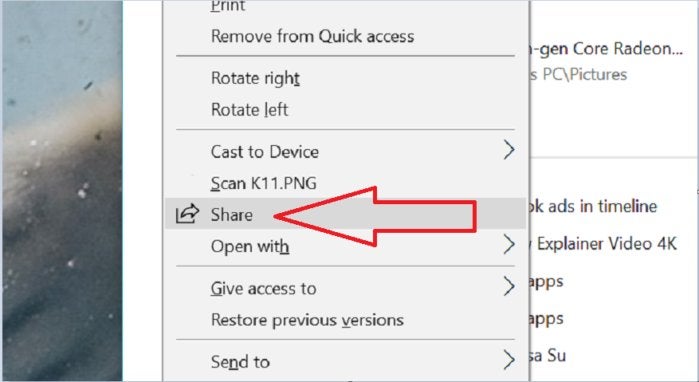 Mark Hachman / IDG
Mark Hachman / IDG Note that inside some apps, such arsenic the variant of OneNote built into Windows 10, the constitutional Share button refers to collaborative editing. In other words, information technology's something of a misnomer: You won't really be beaming the file to another PC, you'll simply let access to it with any privileges the source assigned.
In either Windows Explorer or Edge, clicking the Share button opens the Share window, with the usual options to make the data file available via Mail, Skype, OneDrive, or other installable apps like Facebook. And then in that location's a new tier of options that pops sprouted with Near Share: a list of near devices that you prat beam the file to.
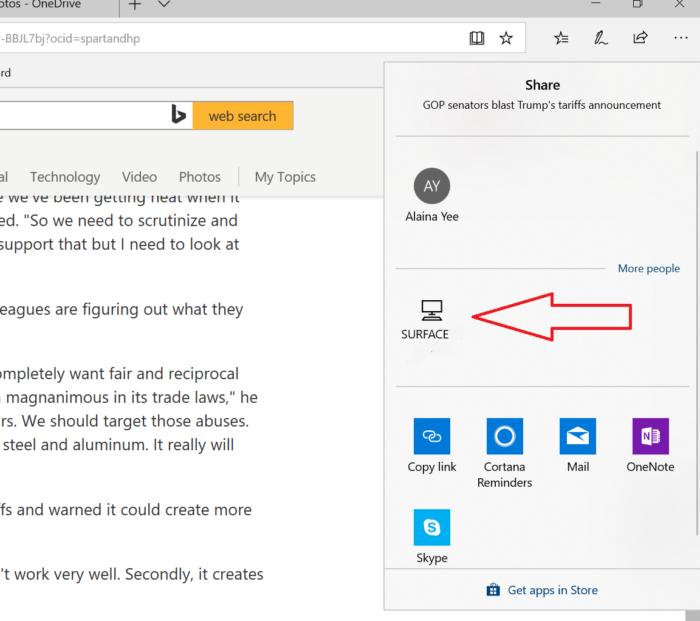 Mu Hachman / IDG
Mu Hachman / IDG If Near Share in properly configured on Thomas More than one PC, you'll see this option when you share a file or Webpage.
Selecting the other PC sends a request to share the file to the other device, which appears as a notification. When the other PC agrees to receive the file, the joint process begins. Remember that the shared folder will come out in the Downloads folder, unless otherwise specified within the Settings menu.
IT's calculative to believe that Wi-Fi plays any role in the least in Near Share, as it's often simply and so dang slow. Exploitation my home office equally a testbed, I found that Near Share works C. H. Best for small files, where emailing them, copying them to a USB pin or uploading them to the cloud is more than cark than it's worth.
I configured Near Share using two PCs—a Surface Affirmative 4 and a Surface Laptop—each sitting inside a fewer feet of one some other within my office. (Microsoft has characterized Near Share as a point-to-item connection, instead than a broadcast to quadruplex PCs.) Using a video file of 47MB as a test, I beamed IT from 1 Personal computer to the other, excruciatingly slowly: an average of 4 proceedings 55 seconds, having born the connection happening the third quiz. I also attached the Laptop to a wired Surface Loading dock, without noticing any significant difference in times.
Was it my network? To check, I proven uploading the unchanged file to OneDrive, pausing my timer, then restarting IT every bit the same file downloaded out of the cloud to the other PC. That took just 1 minute 36 seconds, sporting concluded three times faster than transferring IT via Almost Share.
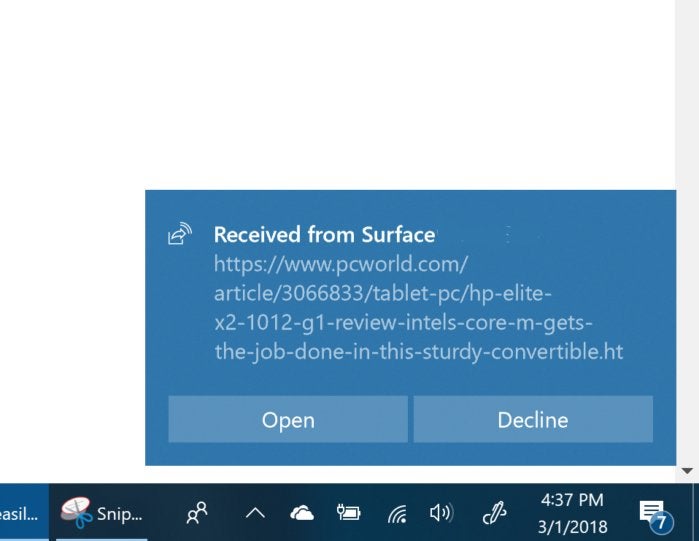 Mark Hachman / IDG
Mark Hachman / IDG The PC that's receiving the file will be notified by Near Share and will have the opportunity to accept or pass up the file. It's a with child joyride for URLs or small files.
According to Computerworld's Skinny Partake in explainer, the feature uses Wi-Fi to transmit all but the smallest files. I didn't have that, at least when I tested in March. Near Share seemed to broadcast basically everything via Bluetooth, whose throughput tops out at or so 3Mbps. That's simply not acceptable for large files, and a USB stick was a removed more practical option. In late Apr, though, I connected the two once again, and even threw an Asus NovaGo into the mix. I really did see file transfers of about 30 Mbits/s using Wi-Fi, but low weird conditions: from the NovaGo to the Opencast Laptop computer, butnot the Surface In favou 4. A firewall issue? Network ironware? Whatever the reason, sharing at replete speed ISN't as simple as it could be.
What Near Shareis good for, still, is cursorily sharing URLs and small files. Windows helpfully asks you whether you'd like to save or save and open a file with Near Apportion. And that means that beaming a URL from unmatched PC to another, and mechanically opening it inside Edge, becomes one of the more pragmatic uses for Near Percentage.
Is that enough? Apps equivalent Word or Dropbox ofttimes purpose for such an eventuality, auto-generating flying golf links to open shared easygoing and sometimes even opening night an associated email app to post them on their way. That hamstrings Near Share's utility.
Near Share arrives literally old age after Apple launched AirDrop, its personal sharing mechanism for MacOS and iOS. It could stand to improve–tell if IT were able to cut and glue between PCs, as Logitech's Flow software or Microsoft's possess Mouse without Borders app can. Almost Share could also welfare from just about sort of broadcast capableness, to send a link up or a file to Sir Thomas More than one PC at a prison term. Microsoft has indicated plans for a "cloud clipboard" are in the works, but it South Korean won't exist available one of these days for this Windows 10 April 2018 Update release. Instead, users will birth to wait for the Redstone 5 release OR later of Windows 10, due this fall.
Near Share's problem is also that progressively users maintain a persistent claver connection, such as Slack or Teams, As a continual backchannel where links can be dropped into a shared chat room. For sharing images or some small files, Near Part is more favourable than sportfishing out a USB stick. At full speed, IT's neat. But right instantly Microsoft could still remain firm to smooth out the kinks.
Source: https://www.pcworld.com/article/407939/windows-10-near-share-wirelessly-beams-files-to-nearby-pcs.html
Posted by: keetonprind1950.blogspot.com


0 Response to "How Windows 10’s Near Share feature wirelessly beams files to nearby PCs - keetonprind1950"
Post a Comment